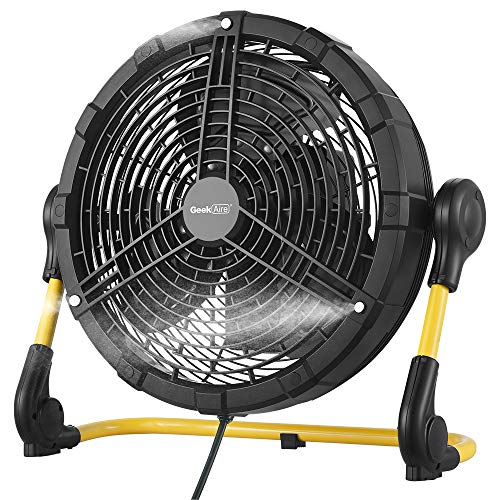Floor Fans: A Comprehensive Guide To Choosing The Right One

- 1. Floor Fans: A Comprehensive Guide
- 1.1. What Is A Floor Fan?
- 1.2. Types of Floor Fans
- 1.2.1. Pedestal Fans
- 1.2.2. Tower Fans
- 1.2.3. Box Fans
- 1.2.4. Floor Drum Fans
- 1.3. Benefits of Using Floor Fans
- 1.3.1. Energy-Efficient Cooling
- 1.3.2. Improved Air Circulation
- 1.3.3. Supplemental Ventilation
- 1.3.4. Portable and Versatile
- 1.3.5. Cost-Effective
- 1.4. Key Features to Consider When Choosing A Floor Fan
- 1.4.1. Airflow and Power
- 1.4.2. Oscillation
- 1.4.3. Speed Settings
- 1.4.4. Noise Level
- 1.4.5. Size and Portability
- 1.4.6. Remote Control and Timer
- 1.4.7. Adjustability and Directional Control
- 1.4.8. Design and Aesthetics
- 1.4.9. Additional Features
- 1.5. Tips for Optimal Use
Floor fans serve as versatile devices that play a pivotal role in ensuring comfortable indoor spaces. Whether your goal is to lower the temperature in a room, enhance air circulation, or introduce a refreshing breeze to a stagnant area, floor fans emerge as a superb and budget-friendly solution. This inclusive guide will delve into all the essential aspects of floor fans, covering their various types, features, advantages, and providing tips for maximizing their effectiveness.
What Is A Floor Fan?
A floor fan is an electric fan specifically designed for placement on the floor, aimed at enhancing air circulation and cooling within a room. Typically comprising a motorized fan blade housed within an enclosure, it is supported by a stand or base for secure positioning on the floor. While floor fans vary in size and design, they commonly feature an adjustable head or oscillating capability, allowing the fan to move horizontally and distribute air more efficiently.
These fans are frequently employed to enhance air circulation indoors, offering relief during warm weather and aiding in the even distribution of warm air during colder periods. Their portability and ease of movement make them a convenient and adaptable cooling solution for a range of settings, including homes, offices, and other indoor environments. Additionally, some floor fans incorporate extra features such as adjustable speed settings, timers, and remote controls, further enhancing their convenience and functionality.
Types of Floor Fans
Pedestal Fans
- Design: Pedestal fans have an upright design with an adjustable height.
- Features: They typically oscillate, providing a widespread breeze. Some models come with adjustable tilt and speed settings.
- Best Use: Ideal for larger spaces or rooms with multiple seating areas due to their ability to cover a broader area.
Tower Fans
- Design: Tower fans are tall, slim units that often come with a vertical fan element.
- Features: They offer a space-saving design, oscillation, and multiple speed settings. Some models come with additional features like ionizers and remote controls.
- Best Use: Suitable for compact spaces and areas with limited floor space.
Box Fans
- Design: Box fans have a square or rectangular shape with a blade system encased in a housing.
- Features: They are simple, affordable, and often have multiple speed settings. Some models can be placed on windows for exhaust purposes.
- Best Use: Great for small to medium-sized rooms, budget-friendly cooling solutions.
Floor Drum Fans
- Design: Resembling a drum, these fans have a cylindrical shape with a powerful motor for increased airflow.
- Features: High airflow, suitable for industrial or large space use. Some models may have adjustable tilt and multiple speed settings.
- Best Use: Perfect for workshops, gyms, or spaces that require high-velocity airflow.
Benefits of Using Floor Fans
Energy-Efficient Cooling
One of the primary advantages of using floor fans is their energy efficiency. Traditional air conditioning units can be notorious for consuming substantial amounts of electricity, contributing to high energy bills. Floor fans, on the other hand, operate using significantly less energy. By opting for a floor fan, you can enjoy a cool breeze without the financial burden associated with running air conditioning continuously.
Improved Air Circulation
Beyond mere cooling, floor fans play a crucial role in enhancing air circulation within a space. Stagnant air can lead to a variety of issues, including the development of mold and mildew. Floor fans effectively combat this problem by promoting constant airflow, preventing pockets of still, humid air. By improving ventilation, floor fans contribute to a healthier indoor environment, reducing the risk of respiratory issues and creating a more comfortable living space.
Supplemental Ventilation
Floor fans can be strategically placed to work in conjunction with your existing heating, ventilation, and air conditioning (HVAC) system. This collaboration enhances overall ventilation and air distribution throughout the room. By strategically positioning floor fans, you can ensure that cool air reaches every corner, creating a more balanced and comfortable indoor climate.
Portable and Versatile
One notable characteristic of floor fans is their portability. Unlike stationary air conditioning units, floor fans can be effortlessly relocated from one room to another, delivering instant cooling wherever it is required the most. This adaptability enables you to focus on particular areas or establish airflow arrangements that align with your preferences.
Cost-Effective
Aside from being energy-efficient, floor fans provide a budget-friendly option for maintaining a comfortable environment. When contrasted with the upfront and upkeep expenses linked to air conditioning units, floor fans prove to be a more economical choice. This cost-effectiveness ensures that they are within reach for various budgets, enabling individuals and families to experience a cool and pleasant living space without straining their finances.
Key Features to Consider When Choosing A Floor Fan
Choosing the appropriate floor fan is a pivotal choice for ensuring a comfortable and adequately ventilated environment, be it at home or in the workplace. Whether your goal is to cool a room, enhance air circulation, or complement your air conditioning system, it's essential to take into account several features to make a well-informed decision. This article delves into these crucial features to assist you in selecting the ideal floor fan tailored to your specific requirements.
Airflow and Power
When selecting a floor fan, it's crucial to take into account its airflow capacity, usually quantified in cubic feet per minute (CFM). A higher CFM suggests superior air circulation, making it well-suited for more expansive areas. Moreover, be mindful of the fan's power consumption. Choosing an energy-efficient model can result in long-term savings on electricity expenses.
Oscillation
Oscillating fans move from side to side, ensuring more even distribution of air throughout a room. This feature is particularly useful for larger spaces where consistent airflow is essential. When choosing a floor fan, consider whether oscillation is a feature that aligns with your needs.
Speed Settings
Look for a fan with multiple speed settings. Having the ability to adjust the airflow according to your comfort level and the size of the room is essential. This flexibility ensures that the fan can adapt to different conditions, providing optimal comfort in any situation.
Noise Level
Some fans can be noisy, which may be disruptive in quiet environments such as bedrooms or offices. Check the noise level rating of the fan and choose a model that suits the noise tolerance of the space where it will be used.
Size and Portability
Take into account the dimensions of the fan concerning the area where you plan to utilize it. Smaller fans are well-suited for compact spaces, whereas larger fans are more appropriate for expansive areas. Portability is also a crucial consideration, particularly if you anticipate relocating the fan from one room to another. Seek out features such as carry handles to facilitate effortless transportation.
Remote Control and Timer
For added convenience, consider a fan with a remote control. This allows you to adjust settings without having to get up, providing a seamless user experience. Timers are also beneficial, allowing you to set the fan to turn off after a specific duration. This feature is not only convenient but also aids in energy conservation, especially during nighttime use.
Adjustability and Directional Control
Look for fans with adjustable height and tilt features, as they offer greater flexibility in directing airflow where it's needed most. Some models even come with vertical tilt and pivot features, providing precise control over the direction of the airflow.
Design and Aesthetics
Consider the design and aesthetics of the fan, especially if it will be a visible part of your living or working space. Choose a model that complements your decor to ensure a seamless integration into the overall aesthetic of the room.
Additional Features
Some floor fans come with extra features such as air purification filters, ionizers, or humidity control. Evaluate whether these additional features align with your specific needs, as they can enhance the functionality of the fan based on your preferences.
Tips for Optimal Use
- Placement Matters: Position fans strategically to maximize airflow. Placing fans near windows for cross-ventilation can be especially effective.
- Clean Regularly: Dust and debris can accumulate on fan blades, affecting performance. Regular cleaning ensures optimal airflow.
- Combine with Other Cooling Methods: Use floor fans in conjunction with other cooling methods for enhanced comfort. For example, use them alongside ceiling fans or air conditioning.
- Nighttime Use: Consider placing a floor fan near your bed for a comfortable night's sleep. Many models come with a sleep mode for quieter operation during nighttime use.
- Safety First: Keep safety in mind by placing fans away from children and pets. Ensure that cords are not a tripping hazard.
In conclusion, floor fans prove to be adaptable and efficient devices, providing a budget-friendly remedy for enhancing air circulation and cooling in diverse indoor settings. With a variety of types and functionalities on the market, there is a floor fan tailored to meet every requirement and personal preference. By taking into account considerations like airflow capacity, speed adjustments, and positioning, you can optimize the performance of your floor fan and experience a pleasant living or working atmosphere.











